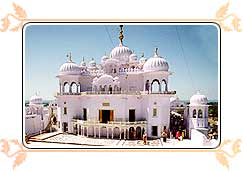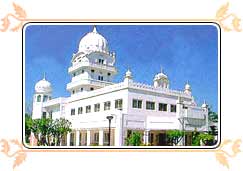SIKHISM
The Sikh religion is
the youngest of all the world's major religions. Founded in India, it traces its
roots to the fifteenth century, when conflict was raging in Northwest India
between Hindus and Muslims. Sikhism arose as an attempt to find a peaceful
resolution to the Hindu and Muslim conflict, with a synthesis based on the
teaching of both. Today there are about 12 million Sikhs in the world, about
ninety percent of which reside in Punjab and the rest have spread around in
other parts of India and the world. There are large Sikh populations in England,
the United States, Canada, East Africa, the Arab Emirates, Iran, Malaysia, and
Hong Kong. The word Sikh basically translates to "disciple". It is easy to
distinguish a traditional Sikh because of the five K's. In 1699 on Baisakhi,
Guru Gobind Singh Ji initiated the five K's. Baisakhi marks the start of
harvesting in Punjab. On this festival, Guru Gobind Singh Ji arrived dressed in
battle gear and carrying a sword. Holding out the sword, Guru Gobind Singh Ji
stated, "My sword wants a head, let any one of my true Sikhs come forward." This
startled everyone present and silence filled the environment, then the guru
repeated his words again. After a short period of time a Hindu man named Daya
Ram stepped forward and the Guru took him into a tent, when the Guru returned
his sword was bloody and a head was in his hands. Upon seeing this some people
began to leave, and others protested; however, the Guru once again repeated the
same words. This time Dharam Das offered his head to the Guru, he too was taken
into the tent and the Guru came out, yet again, with the sword covered in blood
and carrying a head in his hands. This action was repeated three more times. The
other three men where Makham Chand, Himmat, and Sahib Chand.
initiated the five K's. Baisakhi marks the start of
harvesting in Punjab. On this festival, Guru Gobind Singh Ji arrived dressed in
battle gear and carrying a sword. Holding out the sword, Guru Gobind Singh Ji
stated, "My sword wants a head, let any one of my true Sikhs come forward." This
startled everyone present and silence filled the environment, then the guru
repeated his words again. After a short period of time a Hindu man named Daya
Ram stepped forward and the Guru took him into a tent, when the Guru returned
his sword was bloody and a head was in his hands. Upon seeing this some people
began to leave, and others protested; however, the Guru once again repeated the
same words. This time Dharam Das offered his head to the Guru, he too was taken
into the tent and the Guru came out, yet again, with the sword covered in blood
and carrying a head in his hands. This action was repeated three more times. The
other three men where Makham Chand, Himmat, and Sahib Chand.
The fifth time the
Guru returned and showed the heads to the crowd present and went back into the
tent. Soon to everyone's surprise the men came out dressed like the Guru and
wearing swords. It was because of their valiant conduct that the Guru introduced
them as the Panj Pyare -- literally translating to the five beloved. In order to
make them pure Sikhs or Khalsa's the Guru had to baptize them. This baptism was
done by pouring water into a steel bowl, and stirring it with the Guru's sword.
This motion was done in conjunction with the reciting of verses from the Guru
Granth Sahib (the Sikh's holy book), and with the assistance of his wife who
dropped some sugar into the water, "the sweetness mingled with the steel
creating Amrit". This nectar continues to be used in rituals of baptizing Sikhs
today. The five Khalsa's drank the Amrit from the bowl, pledging to equality and
loyalty. It was with this pledge that the five K's were created. The five K's
consists of:
Kesh, the uncut
hair and beard
Kangha, a comb to
care for the hair
Kara, a steel
bracelet representing strength and continuity
Kacha, a loose
short worn by soldiers, and
the Kirpan
which is a sword that symbolizes the fight against oppression.
In addition, to the
five K's the Guru also made a bold move in regards to the caste system on this
day. Each of the individual men who stepped forward came from various castes
within India. A person's caste is easily distinguishable by the last name;
hence, to prevent caste being associated with Sikhs the Guru started a general
last name of Singh. It was the Guru's vision that other Sikhs would, too, adopt
Singh, meaning "lion" or "lion hearted" in replacement to their original last
names for men and Kaur, meaning "princess" for women. In reality, though, this
concept has not truly enacted itself; instead, many Sikhs have used Singh and
Kaur as their middle names. Another social issue that has been addressed by the
Sikh religion is that of equality among the sexes. In Sikhism, women
traditionally hold an important place. Guru Nanak Dev Ji, the first of the ten
Gurus in Sikhism, raised a strong voice in support of women's role in society by
the following famous passage:
Man is nourished in
womb and born from a women.
He is betrothed and
married with a woman.
Friendship is
contacted with a woman and civilization originates from a woman.
When one woman dies,
another woman is sought for because family affairs depend upon a woman.
Why call her bad?
From whom are born kings.
From a woman another
woman is born; none is born without a woman.
This simple passage
illustrates the vision of women in Sikhism. The Guru Granth Sahib -- the holy
book of the Sikhs -- is vital to the Sikh religion. The holy book is meant to
serve as the final guru and as the link between the natural and metaphysical
world. The tenth guru told his disciples that they should not worship idols, but
should worship the holy book for guidance for living and gaining salvation from
the cycle of life. The Guru Granth Sahib starts out with a passage that states
the fundamental beliefs of the Sikh religion:
Ek On Kar There is
one Being
Sat naam Truth is its
name
Karta purkh Creator
of all
Nir bhou Without fear
Nir vair Without
enmity
Akal moorit Timeless
in form
Ajooni Unborn
Sai-bhang
Self-existent
Gur prasad By
Satguru's Grace
In recent years there
has been a push by many religious separatist who mainly because of political
ambitions have attempted to divide the Sikh and Hindu communities. However, the
truth will always be that these two groups are more alike then different. Many
Sikh beliefs originate from the Hindu faith. For example, the name Singh derives
from the Hindi Sanskrit meaning "lion". The Five K's that are so proudly used to
distinguish Sikhs were borrowed from the Rajputs -- the famous Hindu warriors.
Many of the Sikh Gurus names were also drawn from Hindu Gods. For example, Guru
Ramdas (Ram's servants), Guru Harkrishan (Hari and Krishna are Hindu names for
Vishnu), Guru Hargobind (Hari and Gobind also two names for Vishnu). Most people
of the Punjab know that the city of Lahore was built by the elder son of Ram,
Luv, while the city of Kasur was built by Kush, the younger son. A powerful
point is that Guru Gobind Singh states Guru Nanak as being a descendant of Kush,
while himself a descendant of Luv. Also, Guru Gobind Singh Ji himself worshipped
the Hindu goddess Durga in her manifest form. Furthermore, the famous "Golden
Temple" is actually called Harmandir Sahib. Hari is another name for Vishnu, and
Mandir means temple; literally translating into the temple of Vishnu. Hinduism
and Sikhism, then, are very closely related and even when it comes to festivals,
although there are some differences, there are many commonly celebrated days
such as Diwali. For Hindus this festival represents the festival of lights for
the beginning of new year; for Sikhs it is the anniversary of the release from
imprisonment of Guru Hargobind, the sixth guru. Maybe the key difference between
the two religions is the fact that Sikhism is a monotheistic religion whereas
Hinduism is polytheistic one.
 initiated the five K's. Baisakhi marks the start of
harvesting in Punjab. On this festival, Guru Gobind Singh Ji arrived dressed in
battle gear and carrying a sword. Holding out the sword, Guru Gobind Singh Ji
stated, "My sword wants a head, let any one of my true Sikhs come forward." This
startled everyone present and silence filled the environment, then the guru
repeated his words again. After a short period of time a Hindu man named Daya
Ram stepped forward and the Guru took him into a tent, when the Guru returned
his sword was bloody and a head was in his hands. Upon seeing this some people
began to leave, and others protested; however, the Guru once again repeated the
same words. This time Dharam Das offered his head to the Guru, he too was taken
into the tent and the Guru came out, yet again, with the sword covered in blood
and carrying a head in his hands. This action was repeated three more times. The
other three men where Makham Chand, Himmat, and Sahib Chand.
initiated the five K's. Baisakhi marks the start of
harvesting in Punjab. On this festival, Guru Gobind Singh Ji arrived dressed in
battle gear and carrying a sword. Holding out the sword, Guru Gobind Singh Ji
stated, "My sword wants a head, let any one of my true Sikhs come forward." This
startled everyone present and silence filled the environment, then the guru
repeated his words again. After a short period of time a Hindu man named Daya
Ram stepped forward and the Guru took him into a tent, when the Guru returned
his sword was bloody and a head was in his hands. Upon seeing this some people
began to leave, and others protested; however, the Guru once again repeated the
same words. This time Dharam Das offered his head to the Guru, he too was taken
into the tent and the Guru came out, yet again, with the sword covered in blood
and carrying a head in his hands. This action was repeated three more times. The
other three men where Makham Chand, Himmat, and Sahib Chand.